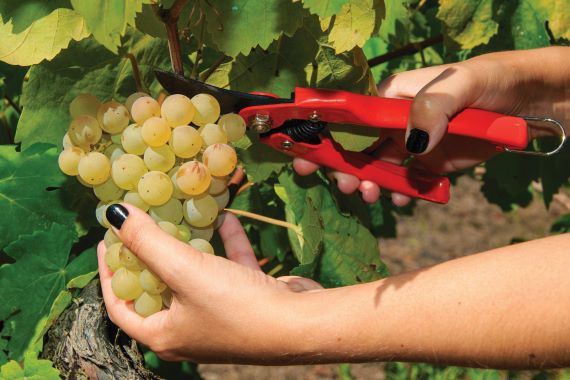Unexpected heatwaves swept across Europe this summer causing wildfires in Greece, France, Portugal and Italy. According to data by Copernicus, June, July and August this year were the warmest on record globally, with an average temperature of 16.8°C, which is 0.7°C above the mean. Rising temperatures are nothing unusual to news channels, but the wet European August was a surprise.
The same report by Copernicus says that central Europe experienced a wetter-than-usual August, with flooding a regular occurrence in several countries. This unpredictable and extreme weather can be difficult to acclimatise to, however, for Europe’s wine industry it’s been a remarkable summer.
“The size of the bunches are huge. It’s not something we’ve seen before,” says Emilien Boutillat, chef de caves at Champagne Piper-Heidsieck. “The combination of heavy rain and high temperatures has been perfect for the growth of our fruit.”
According to David Chatillon, president of the champagne producers’ union, Comité Champagne, the average bunches are thought to weigh around 220g, an all-time high for Champagne compared to the previous record in 2005, at 175g.
Quantity and quality?
“With the weather at the beginning of August, we saw a few outbreaks of the grey mould fungus appear – which we are monitoring closely,” says Chatillon. And on the subject of flavour profile, he adds: "We’ll be able to bring in something really good, and as there’s a lot of quantity, we’ll be able to select better bunches.”
Boutillat adds: “The maturation is a bit unusual. It’s too early to say just how good the harvest will be in terms of quality, but the early signs suggest that Chardonnay could be quite exciting, but for the Meunier and Pinot Noir it’s still a bit early to comment.
“We’ve seen quite low sugar levels, lower than we’ve seen over the past few years, which is a bit strange, but we have the luxury of picking only the best grapes this year, which is very important.”
With these exceptionally large bunches, more champagne could be made in 2023 than ever before. However, each year Comité Champagne puts a limit on the number of grapes that can be harvested depending on a combination of natural and economic circumstances. Earlier in the year this figure was set at 11,400kg/ha – around 326 million bottles across the appellation.
This number is down around 5% on 2022 and Chatillon says the chosen cap was a reflection of current worldwide economic challenges.
“To determine the available yield for the year, vinegrowers and houses have agreed on shipping forecasts for the next four years that take into account both our confidence in the appellation, and a certain caution with regards to the global economic situation and the effects of inflation,” he adds.
Reserves
To accommodate for unusually large yields, producers can harvest their grapes and store the wine, known as a reserve, which can be used to help producers make consistent blended non-vintage wines should there be a shortage of grapes in the future. Luckily, while the harvest was limited by Comité Champagne, the agreed reserve for 2023 is big – almost an entire extra harvest worth. The reason for having a large reserve is a combination of unpredictable weather conditions and the consistent decrease in yield year on year, which is due to the ageing of vines, increasing temperatures and the implementation of more sustainable farming practices. But given the unusually high yield this year, the reserves of champagne houses in 2023 will likely be maxed out to cover future shortcomings.
It’s worth noting that while the harvest cap is lower in 2023 than previous years, so too is the overall consumption of champagne. According to Comité Champagne figures, the first half of 2023 saw a drop in domestic sales of champagne at around 6% – or 48 million bottles – while exports were down 3.7% or 77.7 million bottles. This is a likely result of the cost of living crisis hitting Europe and inflation continuing to soar across the world.
On a more positive note, the association of champagne with celebratory moments and special occasions has never been stronger. Gong, the Shangri-La cocktail bar on the 52nd floor of The Shard in London, is a popular destination for special gatherings and has sold £2.7m of champagne so far this year.
Director of food and beverage at Shangri-La, Ela Shehu, says: “We obviously have lots of celebratory guests. We sit in the uber luxury category and the majority of our visitors are there to celebrate, and naturally champagne is a regular order.
“There’s been an increase in costs when it comes to buying champagne, quite a drastic one in fact. But even with our own prices having to increase there doesn’t seem to be a slowdown in consumer spending.”
Shehu says that champagne afternoon tea is the most sold package at the hotel and at Gong, champagne is the bestselling drink after cocktails.
She adds: “We had actually expected a knock-on effect from the cost of living crisis and the rise of inflation, but it hasn’t had any impact. Gong has sold 2,000 bottles of house champagne (Veuve Cliquot) since January.”
As it stands, 2023 is a year of intrigue for Champagne. Record yields combined with more restrictive harvests are a strange combination. But it means reserves for future wines will be plentiful and the Comité Champagne deserves credit for servicing the current demand for its fizz, while also protecting future harvests with healthy reserves – particularly as temperatures continue to rise and weather becomes more extreme.
When it comes to the quality of this bountiful harvest, it’s difficult to be authoritative at time of writing, but Boutillat sums it up nicely: “We know that in Champagne, big quantity can also mean big quality.”




